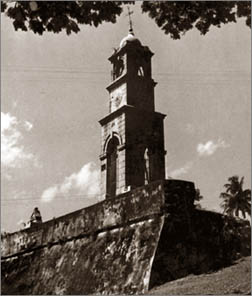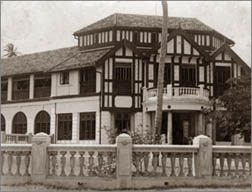|
observer |
|
|
|
|
|
OTHER LINKS |

|

|

|
Historic Negombo
Sunny beaches add lustre to this city. Like many historical cities Negombo is inextricably woven into history. It is said in folklore that, when Queen Viharamahadevi was expecting she had a craving to taste a honeycomb from Negombo. To her surprise she found a large honeycomb built in a bound boat in Negombo bay. Negombo is the hub of the fishing industry. Fisheries trade in Negombo has a long history going back to the 18th century. It is also said in folklore that King Dutugemunu's royal elephant (Kadol Atha) was an elephant that was found from (Kadol Kalle) area. The monuments that are found in Negombo reveal the ancient history of this city and serve as landmarks inherited from the Portuguese, Dutch and the British rule. The relevant authorities neglect this historical city. A new city has sprung up while preserving old landmarks of the town. Many unchanged physical features of the city serve as evidence of its past splendour. The Dutch East India Company (V.O.C.) between AD 1644-1796 built the eastern wall of the fort and the parts of the moat and the street patterns are focused towards the fort. These are remains of foreign rule. There is documentary evidence to prove the existence of a Portuguese enclave located in the area but further study has to be done to establish the factual nature of it. The Dutch Hamilton canal heading from the North to the lagoon is another landmark site. The canal was used as a ferry for transport. This canal carried the waste water from the city to the lagoon. The location of the canal in the midst of the city surrounded by settlements and buildings makes the canal an integral part of the city of Negombo. The large ancestral houses and buildings seen in the city were built during the Dutch and the British periods. They depict the architectural models used by the Britishers and the Dutch. The Anglican Church, which stands on one of the Bastions of the Fort, the now defunct clock tower, which is constructed adjacent to the wall of the Fort are monuments inherited from the British and Dutch periods. The social and cultural diversity of this city is worth mentioning. Traditional, Religious pageants, Dramas and Festivals gather large congregations. The Mangrove lands, Mangrove islands variety of Marine species and Coral Reefs make Negombo a repository of natural reserves capable of attracting many tourists. The Ethno Religious diversity seen in Negombo is incomparable with the other major cities of Sri Lanka. The peaceful coexistence that exists among the Sinhalese, Tamils, Muslims and Burghers is highly admirable. The remaining heritage sites of Negombo is fast disappearing due to human activities. It is high time that the authorities take action to preserve the artifacts of Negombo as it is a major source of tourist attraction capable of bringing sound economic benefits to Sri Lanka. (Future - The Pride of Sri Lanka) |













